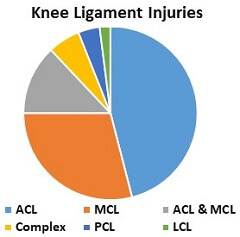Nobody needs to read this. This is stuff nobody needs to read but me. This is the output of all of the research I did on my knee, which is all that I'm concerned about right now. If you're on fire and I have a bucket of water and a computer, I'm going to be doing research on my knee, not dousing the flames.
The salient information for me is that if I take the time, visit competent sources, listen to trusted voices (www.you'regoingtodietoday.com is not a trusted voice) then I'm going to find a consensus, a balance, a median between reasonable extremes. Facts begin to shake out. Bullshit begins to fade.
The facts is the facts.
A twisted knee is one of the most common way the joint gets injured. This type of injury most commonly occurs during sports or by falling awkwardly. Depending on how the knee twists, it places stress through different structures of the knee so accurate knee pain diagnosis is vital.
Most commonly, it is the ligaments or cartilage that get damaged when the knee over-twists. Ligament injuries tend to cause ongoing problems with stability and the knee may frequently give way even months after the initial injury.
Cartilage injuries tend to cause pain and swelling, may limit knee movement, and at times can cause the knee to get stuck. In more serious injuries, multiple structures may be damaged.
Grade 1 Recovery Time - If you have suffered a grade 1 MCL tear, recovery time is usually under two weeks. In fact, some people return to sports or exercise in one week.
UCSD
Treating MCL Injuries
Treatment starts with rest, ice and elevation to ease pain and swelling. In the next stage, you start exercises (physical therapy) to improve your knee’s range of motion, strength, and flexibility. You may need a brace for weeks after your injury. Using crutches or a brace rests your joint, helping it to heal.
The vast majority of MCL injuries heal well without surgery.
UCSF
Recovery times differ depending on the severity of the injury:
- A minor, or grade 1, MCL tear can take from a few days to a week and a half to heal sufficiently for you to return to normal activities, including sports.
- A grade 2 tear can take from two to four weeks to heal.
- A grade 3 tear usually takes from four to eight weeks to heal, unless it is associated with damage to the ACL, in which case the recovery time may be longer.
Mass General
Rehabilitation after Injury to the Medial Collateral Ligament of the Knee
Phase 1: The first six weeks after injury (grade 2 and 3)
three weeks after injury (grade 1).
The knee should be protected with a short-hinged brace for 3 to 6 weeks,
depending upon the severity of the injury. Crutches and restricted weight bearing
may be needed, as instructed by the doctor. Apply ice to control swelling. Elevate the leg and use elastic stockings if the leg is swollen. As the pain
lessens and the swelling decreases, try to gradually regain knee motion. Avoid pivoting or twisting the knee because it might be unstable and give
out. Be careful getting out of cars, or catching your toe on a rug. When
walking, bear weight according to your doctor’s instructions. Progress to no crutch(es) or brace when you can walk without a limp and
there is no pain (per doctor instructions). Ice the knee if there is pain
and swelling. Place a towel or cloth between the skin and the ice to prevent
skin injury. Ice for 20 minutes, three times a day. At about two or three
weeks following injury, the pain is usually subsiding and the swelling
is lessened. You can now try to stretch the knee to regain motion.
Stationary cycle and swimming (flutter kick only) are recommended.
HARVARD
Grade I (mild) — This injury stretches the ligament, which causes microscopic tears in the ligament. These tiny tears don't significantly affect the overall ability of the knee joint to support your weight.
Grade II (moderate) — The ligament is partially torn, and there is some mild to moderate instability (or periodic giving out) of the knee while standing or walking.
Grade III (severe) — The ligament is torn completely or separated at its end from the bone, and the knee is more unstable.
How long a knee sprain lasts depends on the type of knee sprain, the severity of your injury, your rehabilitation program, and the types of sports you play. In general, milder Grade I and Grade II MCL or LCL sprains heal within 2 to 4 weeks, but other types of knee sprains may take 4 to 12 months.
How long will it take to recover?
- A mild MCL injury or grade one sprain should take 3 to 6 weeks to make a full recovery.
- A more severe grade 2 or grade 3 injury may take 8 to 12 weeks.
When a Grade II sprain occurs, use of a weight-bearing brace or some supportive taping is common in early treatment. This helps to ease the pain and avoid stretching of the healing ligament. After a grade II injury, you can usually return to activity once the joint is stable and you are no longer having pain. This may take up to six weeks. Physiotherapy helps to hasten the healing process via electrical modalities, massage, strengthening and joint exercises to guide the direction that the ligament fibres heal.
Recovery From An MCL Injury
Recovery from an MCL injury is very dependent on the grade of your MCL tear. Recovery from a grade 1 MCL injury can be as short as a few weeks. Once your range of motion and strength have recovered most grade 1 MCL injuries can anticipate a full return to sports. MCL injuries do tend to be painful so the pain from the injury might linger on for a month or two.
The recovery from a grade 2 MCL injury will take a while longer. A grade 2 injury might take between 2-3 months until you are comfortable, the knee is stable and your motion and strength have returned to normal. Once you have sustained a grade 2 or 3 injury it is also very important to focus on sports specific rehabilitation and neuromuscular rehabilitation to make sure that your knee is ready to compete.


No comments:
Post a Comment